
Bill Kroske had been doing an outstanding job as the CEO of the Region while I was involved with the
Sales Management Academy and later in the Senate. When we sold the Region back to Century 21 in 1982,
his well earned bonus was a substantial percentage of the sales price.
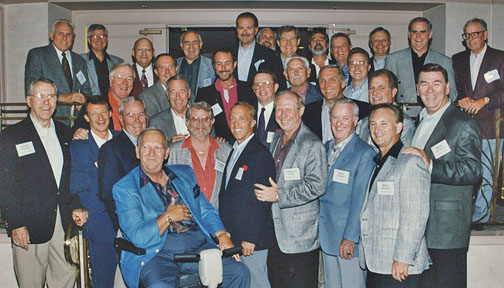

In 2008, thirty-seven years later, Century 21 had 147,000 agents and 84,000 offices located in 58
countries. Still, the largest company in the world.

But, one broker who didn’t buy told me that while franchises might sell hamburgers they would never
sell real estate.

At our New Orleans convention I was crossing the street from the convention hall to the hotel when an
Arizona broker who had attended the course recognized me and introduced me to a sales lady who was
with her. Lunch was included in the convention package and when I arrived later, they were in line
just ahead of me so I joined them. Carolyn Cook was the agents name.
Our marriage had slowly declined over a long period and I can see now how it could have been prevented.
However, I can’t blame Marguerite. She didn’t know how to cope with our growing apart any better
than I did.

Carolyn was divorced, had custody of their four children and moved to Long Beach handling the sales of
my presentation and films and scheduling seminars. We were married three years later.

When did the politicking start? Probably when I joined the Junior Chamber (Jaycees) in 1946. Everyone
was interested in getting a toe hold in the community, and the Jaycees made it easy with several
committees and projects. The membership grew to 500 as the veterans came home or came because they
had gone through here during the war. The committees consisted of Health, Education, Aviation, Public
Affairs and of course, The Speakers' Forum. And, when special projects came along there would be a
committee formed for it. We had regular meetings called, "Peon University" to indoctrinate our new
members which also was referred to as, "Peon U by the Sea."

Using my GI eligibility I had attended two Dale Carnegie "How to Think On Your Feet" courses which
emphasized, use it or lose it. A husband of one of Marguerite’s friends told me about a Jaycee program
called "The Speakers' Forum" so I attended their next meeting and then joined the Jaycees. In addition
to improving speaking skills we also learned Robert’s Rules of Order, in-depth. At the first State
Jaycee meeting I attended in Bakersfield I stopped the meeting twice on "Points of Order" and was
upheld on both counts by the Parliamentarian. From the reaction it was apparent it had never
happened before.
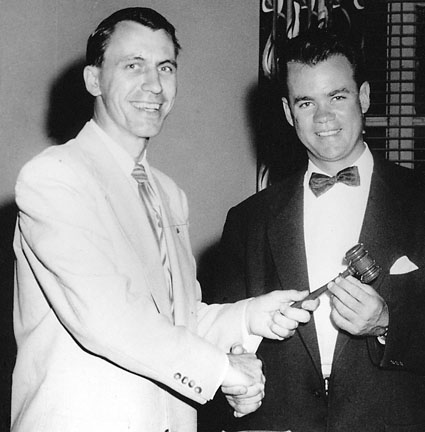

Dave Eagleson an attorney in the photo on the left was also a member of the "Forum". He was appointed
as a judge and later, an Associate Supreme Court Justice by Gov. Deukmejian. Dave would stay with us
when he had to be in Sacramento.

I met Richard Shelley, an Architect, in the Jaycee City Planning Committee and we became friends.
Later I built a condo he designed and when my construction business went under I worked for him a
short time as a draftsman. Dick went on to build hotels and worked for the World Bank developing
resorts in Micronesia. Years later he was Best Man when Anne and I were married.


Governor Deukmejian appointed another former Jaycee, Malcolm Lucas as Chief Justice and when the Court
met in Sacramento we would golf at Rancho Murrieta and then dine at Frank Fats. The number of former
Jaycees from Long Beach was a Governor, two Supreme Court Justices and a Senator.
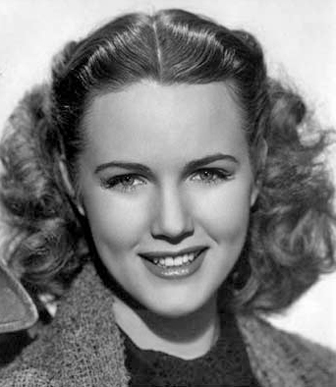

I was in the 7th grade when I fell in love with Barbara Brantingham but I had to settle for friendship.
Louis Sloggy and I would meet at her home for home work and special projects.

In 1940 she was chosen Queen of the “Fylke” (Festival) at Long Beach Community College. She also stared
in their production of the "Old Maid", which Marguerite and I attended and where she was spotted by a
studio. They changed her name to Britton and she made seven movies, several Broadway plays, two TV series
and was Revlon’s spokeswoman for 12 years. Married with four children she regrettably succumbed to
cancer in her fifties.

As a Jaycee National Director I had attended a Hollywood Jaycees District meeting. As the "Honorary Mayor
of Hollywood" her place card was also at the head table so I moved my place card next to hers and we had
a great visit.

Her father worked for the Water Department, and when he retired I was the Chairman of the Water Board
and enjoyed awarding him his retirement memento.

Ira Kay was President of the San Pedro Junior Chamber. He and his brother had a Army Surplus Store and
we became good friends. He moved up the Jaycee chain of command to State President and then President
of International. Because of his travels, and Jaycee International contacts he went into business in
Hong Kong.

Years later Marguerite and I traveled to Thailand to visit Sombat and Sugonya and stopped to see Ira
in Hong Kong. We had a great visit and I learned a lot about doing business there. At the time he
owned a taxi company and a knitting mill.

When I visited him again about ten years later he also owned a fine restaurant where he entertained
us. He had sold his taxi company and explained why you should never own a cash business in the east.
He was living on his yacht and was the Rotary District Vice President of a huge district that included
other countries. When I mentioned golf he arranged for me to play at a private club the British had
establish many years before and sent his limo deliver me and pick me up.
His Mother had died in San Pedro and for months while she was ill he had flown to visit her every
weekend. He was a good man in every way.

In 1954 City Manager Sam Vickers called to inform me I had been appointed to the Long Beach Water
Commission. Jerry Desmond, who was the Jaycee President when I joined the Jaycees, was on the City
Council and championed to get younger blood on the City Commissions. I was 33 and my age made a big
dip in the five Commissioner’s average age. The bridge over the LA river from Long Beach to Terminal
Island is named after Jerry.

It was an autonomous department with the oversight of the City Council limited to the approval or
rejection of the annual budget. They did not have a line item veto power which left our decisions
out of the political arena. However, they never hesitated to let us know if there was something
they preferred changed.

As an example they wanted us to add an amount to the water bills that we would transfer into the general
fund. This would be a "hidden" tax since the tax payers would assume they were only paying for their
water. Some of the commissioners were willing to go for it but since private water companies had to
pay taxes we finally agreed it would be fair for the Water Department to pay an amount equal to the
amount of tax a private company would pay. That was straight forward and City Hall approved because
they didn’t have a choice.

Some of the significant improvements during my fifteen years were:
- Creating a redundancy though out the system providing for continuous service in all areas regardless
of a breakdown in a major line.
- Increasing our storage capacity by constructing additional storage tanks in the Dominguez Hills.
- The creation of an industrial park on land owned by the Water Department that returned nearly
two-hundred acres of land plus many businesses to the tax rolls.
- Cleaning and lining old, iron water mains to increase their life span and their delivery capacity.
- Participation in the adjudication of the regional underground water basin that encompasses much of
Los Angeles County and stretching from the San Gabriel River north for 25 miles thus assuring our fair share.
- Participation in the creation of the regional plan to purchase off peak water from the Metropolitan
Water District to be spread at the Whittier Narrows for storage in the underground basin.
- Contracted for County reclaimed water and constructing lines to deliver it to parks and golf courses.

Long Beach had artesian springs in the beginning but the last well we drilled went to 1400 feet before it
brought in a consistent flow. To stop the salt water from the sea intruding into the lowered water table,
fresh water barriers were created by drilling wells in key locations and injecting fresh water.

I was privileged to tour the California Aqueduct and the Oroville Dam while they were under construction
as well as the Metropolitan Water District Aqueduct that included three dams, several reservoirs, miles of
aqueduct and lift stations. The foresight of our early leaders and their history of water development is
remarkable.

A bill to construct a peripheral canal around the Sacramento delta was carried by my seat-mate, Senator
Rubin Ayala. It was defeated by the northern California water interest but it is back in consideration
today because two thirds of our population is in southern California and facing water shortages. The
courts recently ruled that the aqueduct water passing through the delta had to be cut by 25% because the
pumps were killing delta shrimp. A peripheral canal would carry the water around the Delta and help alleviate
the Southern California water problem. It will also help stabilize the Delta in addition to saving the fish.
In addition to the shortage created by that the water available from the Colorado River is diminishing and
our growing population requires even more water.
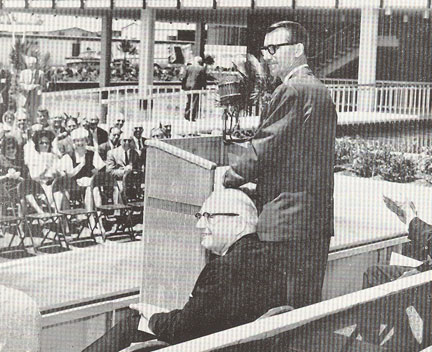

We had out grown the Water Department Headquarters which were located downtown in the City Hall. To increase
our efficiency we needed to be in the same location as our shops, equipment and supplies located on Wardlow
in the center of the city on a site we owned. When the Council became aware of our plans they pressured us
to build it downtown to upgrade the downtown area. All Board member stood fast and we built it where it
would best serve the City on land we already owned for considerably less than on any site downtown. I don’t
remember the year but I officiated at our dedication ceremonies. The date and Board members are listed on a
bronze plate at the building entrance.

Century 21 International became less demanding of my time and Kroske was building the Region so I began to
take an interest in State politics. Governor Reagan’s appeal for more efficient and less costly government
highlighted the waste and failure of many State programs. I volunteered for one of his citizen’s committees.

That led to the Chairmanship of the 31st Senate District Republican Central Committee which was Deukmejian’s
district. At that time it included Long Beach, Lakewood and Los Cerritos and the Democrats had a six percent
edge on registration.

The Committee’s headquarters was a dumpy 30 foot wide store front located on a side street off of Wardlow
so you can picture how appealing it was. The interior matched the exterior and it was staffed with elderly
volunteers who were devoted, did their best and saved everything that had to do with anything for years. Most
of their time was spent visiting on the phones with the ladies of our three Republican women’s groups. Their
constructive efforts were folding, stapling and stuffing mailers and working on telephone banks when and if
there were any. The whole Central Committee effort was uncoordinated and failed to provide the leadership
necessary to win elections or to encourage candidates.

Other Central Committee members were future Congressman and California Attorney General, Dan Lungren and
his wife Bobbi, who was expecting their first child, and Dennis Brown, a future State Assemblymen and
Senator. We started by loading all the junk and hauling it to the dump. Then we painted, a flooring
supply store installed a new floor, an electrical company provided better lighting and a window covering
company installed new blinds. We also raised the money to hire a professional manager to build our lists
of financial contributors as well as volunteers. What a difference! When someone walked in they weren’t
discouraged and we were prepared for the coming elections.
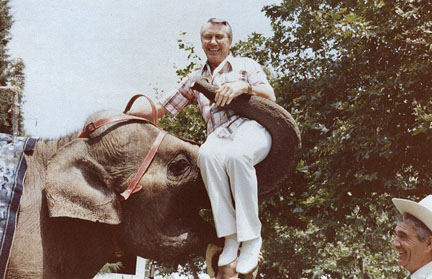
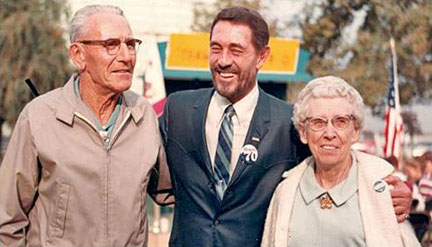

We put out the word that we were there to assist all qualified candidates and held an old fashioned 4th
of July picnic. Cal Worthington brought his elephant who gave me a lift with his trunk but the hair on
the beast is like a coarse file and removed some skin on my arm. Thirty-eight years later Cal is still
hustling his cars on TV.

Dan Lungren, who had run for Congress and lost by a narrow margin began to prepare for the next election
which he won by a narrow margin. I recently attended one of his campaign rallies in Sacramento just before
he was reelected again to Congress and was able to visit with him and Bobbi and two of their children. He
surprised me by taking time to introduce and thank me for my support in his early political battles.

Senator Deukmejian was beginning to assemble support for his run for Attorney General in the middle of a
four year Senate term that would require a Special Election to replace him. As the time drew near he
called me and we met for lunch. His concern was finding a candidate who could beat Council woman, Renee
Simons, who had run against him four years before and had done well.

Renee was coming up for reelection to the Council and it’s easier to beat a looser than a winner so we
decided she had to taken out. The main City issues at the time were "integrated bussing" and, City
employees who wanted "binding arbitration" in wage and benefit disputes.
Binding arbitration looks good on the surface until you realize that the elected Council members,
who are accountable to the voters, will not be at the bargaining table. They will be replaced by
unknown arbiters who have no ties to the City and who will decide what is best regarding the City’s
largest expense consisting of wages and benefits.

At the time Council members were elected by the District in which they lived and we had a viable candidate
living in Simon’s District. As Chair of the Central Committee I sent out a letter to the Republicans in
that District pointing out that Renee Simons was supporting both "bussing" and "binding arbitration".
We won by less than one hundred votes so I felt our strategy and the letter did their job, Simons would
be running for the Senate as a looser, not a winner. At the time I didn’t know I would be her opponent.

I had talked to Tom Clark, a several term Councilman, a popular Mayor and my eye doctor about running.
But, he had two sons in college and couldn’t afford to give up his practice and survive on a Senator’s
$28,000 a year salary and the $40 per diem.
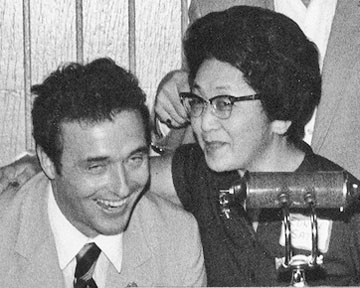

Our advisory group agreed that none of those who had indicated they were willing to run had a chance and
at a one of our meetings someone asked me why I didn’t run. I had considered it but was afraid of it being
an ego trip and winding up the looser. So, before I decided I hired Bill Roberts who had managed Deukmejian’s
Attorney General campaign, to do a study to determine if I had a reasonable chance of winning. He came back
and gave me these reasons why I could win: I was on the right side of the main issues; I would be identified
as a "Businessman" on the ballot which was more popular than Simons", "Attorney’; I could raise the money
it would take; She had a 25% negative name recognition and since I had no name recognition it would be
easier to build a positive one than for her to overcome her negative. And lastly he said, “You look like
a Senator.” I thought of how most of them looked and thought about forgetting to pay him.
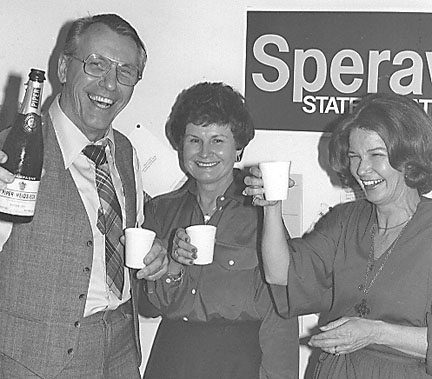

We won the primary against three others including Mayor Sato and entered the election against the Democrats'
6% edge in registration. It took 0ver $200,000 (Big money at that time.) some great mailers and a hard
hitting, "get out the vote team" that included the Party busing in out-of-towners who walked precincts
that included several Senators and Assembly members. We won by 5%, not bad considering the Democrat’s edge.

However, it was a sad reflection on our electorate. I was elected by approximately 10 percent of those eligible
to vote had they been registered and voted. But why bother to vote, it was just a Special Election with
nothing important on the ballot except the election of a Senator to represent them.
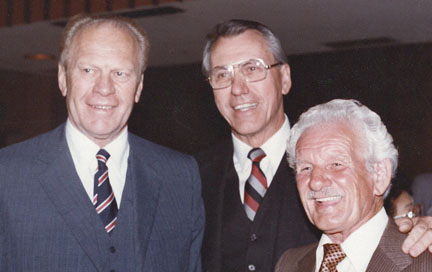

Bill Kroske’s dad, Howard, worked on my campaign doing everything from walking precincts to painting large
signs. He’s in the photo on the right. The guy on the left was some ex-president who used it as a photo op
when he spoke at one of my fund raisers.

